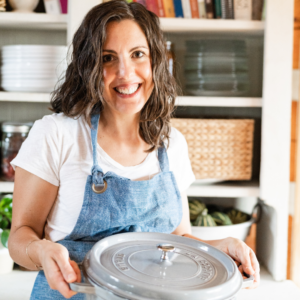40 Ways to Eat More Real Food

This post may contain affiliate links, which means I make a small commission at no extra cost to you.
See my full disclosure here.
Most people agree it’s a good idea to avoid processed foods and eat more real food instead. But it can be overwhelming to know where to start!
I remember feeling overwhelmed at the beginning of my family’s journey towards real food. We started by cutting out certain things and emphasizing other things.
Then we moved on to tackle other parts of our diet. Over time, we made quite a shift, but that transition was made up of many baby steps in the right direction.

Baby steps
If you’re looking to eat more real food and less processed foods, here are 40 baby steps that will take you in the right direction. If you’re new to eating real foods, do not attempt to do all of these at once! That’s a recipe for disaster.
Instead, I recommend choosing 3-5 steps and commit to making them a habit. Once those steps feel normal-ish, add another 2-3 steps. And so on.
By the way, I am so passionate about helping others eat more real food because I have seen what a difference it has made for my own family. I went from feeling totally overwhelmed about what to eat and how to prepare real foods (and how to find recipes my kids would like), to having a solid system in place for simple, healthy meals. I want to help you do the same, with my Real Food Family Meal Plan!
40 Ways to Eat More Real Food
Get the printable version of this list in my Resource Library.
- Watch the documentary Food, Inc.
- Replace your table salt with unrefined sea salt.
- Bake with honey or maple syrup instead of refined sugar. Look for local, raw honey, and high quality maple syrup.
- Replace sodas with water. For flavor, add citrus slices, fresh squeezed citrus juice, or (even easier!) therapeutic grade essential oil.
- Replace fruit juice or power drinks with kombucha.
- Replace non-dairy creamer with raw milk, butter, or coconut oil. Consider “bulletproof coffee”.
- Replace store-bought salad dressings with high-quality olive oil and balsamic vinegar. Add salt (unrefined sea salt) and pepper to your salads for extra flavor.
- Find a good source for pastured poultry. (Avoid grocery store chicken.)
- Find a good source for pastured pork. (Avoid grocery store pork & bacon.)
- Find a good source for grass fed beef. (Avoid grocery store beef.)
- Find a good source for raw cheese. (Avoid processed cheeses.)
- Find a good source for raw (or almost raw), whole milk. (Avoid grocery store milk.)
- Find a good source for butter from grass fed cows. (Avoid margarine and processed butter.)
- Look for high-quality, full fat sour cream.
- Find a good source for local, pastured eggs.
- Find a good source for local, unsprayed fruits.
- Find a good source for local, unsprayed veggies.
- Find a good source for wild caught salmon and other fish. (Avoid farm raised fish.)
- Serve 2-3 veggies (or more!) with every dinner.
- Learn the art of simply prepared veggies: sautéed in butter or bacon grease with salt and pepper or roasted at 400° F in coconut oil or butter.
- Add extra veggies to every possible dish: taco meat, soups, smoothies, etc.
- Eat protein and healthy fats at every meal.
- Don’t skip breakfast! Make sure your breakfast contains protein and healthy fats.
- Follow a meal plan.
- Learn to prepare a whole chicken. It’s the most cost-effective way to eat pastured poultry and the leftover meat is wonderfully versatile.
- Learn to make your own bone broth. Make it regularly.
- Use your homemade broth to make at least one soup every week. Make extra soup, for leftovers throughout the week.
- When you cook, always multiply the recipe in order to have plenty of leftovers.
- Learn to use and love your crockpot. (Or instant pot.)
- Keep high-quality gelatin on hand. Find ways to incorporate it into your diet. The easiest way is to add it to your beverage of choice on a regular basis: smoothies, coffee, coffee substitute, etc.
- Do not cook with olive oil. Use coconut oil or butter instead. Use olive oil for cold foods only, such as salad dressing.
- Identify several healthy snacks and keep them on hand for yourself and for your children.
- Create a habit of packing healthy snacks when you’ll be away from home.
- Decide about grains. If your family will continue to eat grains, learn to soak them before cooking.
- If your family will avoid grains, identify replacements.
- Replace pasta with zucchini noodles or spaghetti squash.
- Replace rice with cauliflower rice or other veggies.
- Replace breads, crackers, and other baked goods with homemade, grain-free versions.
- Decide about beans. If your family will continue to eat beans, start with dried beans and learn to soak and cook them.
- Learn to soak and dehydrate nuts.
Are you trying to eat more real food? Which steps have you already implemented? Which steps are next?

Sign up NOW for my best tips delivered weekly to your inbox!
You’ll also get instant access to my library of free ebooks and resources.






Leave a Comment